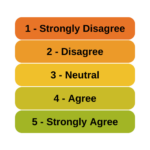 Interactions in statistical models are never especially easy to interpret. Throw in non-normal outcome variables and non-linear prediction functions and they become even more difficult to understand. (more…)
Interactions in statistical models are never especially easy to interpret. Throw in non-normal outcome variables and non-linear prediction functions and they become even more difficult to understand. (more…)
Stage 3
Member Training: Interactions in Poisson and Logistic Regression
The Difference Between the Bernoulli and Binomial Distributions
 You might already be familiar with the binomial distribution. It describes the scenario where the result of an observation is binary—it can be one of two outcomes. You might label the outcomes as “success” and “failure” (or not!). (more…)
You might already be familiar with the binomial distribution. It describes the scenario where the result of an observation is binary—it can be one of two outcomes. You might label the outcomes as “success” and “failure” (or not!). (more…)
Member Training: Translating Between Multilevel and Mixed Models
 Multilevel and Mixed models are essentially the same analysis. But they use different vocabulary, different notation, and approach the analysis considerations in different ways.
Multilevel and Mixed models are essentially the same analysis. But they use different vocabulary, different notation, and approach the analysis considerations in different ways.
(more…)
Member Training: Analyzing Likert Scale Data
 Is it really ok to treat Likert items as continuous?
Is it really ok to treat Likert items as continuous?  And can you just decide to combine Likert items to make a scale? Likert-type data is extremely common—and so are questions like these about how to analyze it appropriately. (more…)
And can you just decide to combine Likert items to make a scale? Likert-type data is extremely common—and so are questions like these about how to analyze it appropriately. (more…)
Member Training: A Gentle Introduction to Bootstrapping
 Bootstrapping is a methodology derived by Bradley Efron in the 1980s that provides a reasonable approximation to the sampling distribution of various “difficult” statistics. Difficult statistics are those where there is no mathematical theory to establish a distribution.
Bootstrapping is a methodology derived by Bradley Efron in the 1980s that provides a reasonable approximation to the sampling distribution of various “difficult” statistics. Difficult statistics are those where there is no mathematical theory to establish a distribution.
When Linear Models Don’t Fit Your Data, Now What?
When your dependent variable is not continuous, unbounded, and measured on  an interval or ratio scale, linear models don’t fit. The data just will not meet the assumptions of linear models. But there’s good news, other models exist for many types of dependent variables.
an interval or ratio scale, linear models don’t fit. The data just will not meet the assumptions of linear models. But there’s good news, other models exist for many types of dependent variables.
Today I’m going to go into more detail about 6 common types of dependent variables that are either discrete, bounded, or measured on a nominal or ordinal scale and the tests that work for them instead. Some are all of these.
